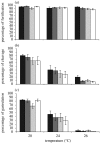Temperature, but not pH, compromises sea urchin fertilization and early development under near-future climate change scenarios
- PMID: 19324767
- PMCID: PMC2674501
- DOI: 10.1098/rspb.2008.1935
Temperature, but not pH, compromises sea urchin fertilization and early development under near-future climate change scenarios
Abstract
Global warming is causing ocean warming and acidification. The distribution of Heliocidaris erythrogramma coincides with the eastern Australia climate change hot spot, where disproportionate warming makes marine biota particularly vulnerable to climate change. In keeping with near-future climate change scenarios, we determined the interactive effects of warming and acidification on fertilization and development of this echinoid. Experimental treatments (20-26 degrees C, pH 7.6-8.2) were tested in all combinations for the 'business-as-usual' scenario, with 20 degrees C/pH 8.2 being ambient. Percentage of fertilization was high (>89%) across all treatments. There was no difference in percentage of normal development in any pH treatment. In elevated temperature conditions, +4 degrees C reduced cleavage by 40 per cent and +6 degrees C by a further 20 per cent. Normal gastrulation fell below 4 per cent at +6 degrees C. At 26 degrees C, development was impaired. As the first study of interactive effects of temperature and pH on sea urchin development, we confirm the thermotolerance and pH resilience of fertilization and embryogenesis within predicted climate change scenarios, with negative effects at upper limits of ocean warming. Our findings place single stressor studies in context and emphasize the need for experiments that address ocean warming and acidification concurrently. Although ocean acidification research has focused on impaired calcification, embryos may not reach the skeletogenic stage in a warm ocean.
Figures
References
-
- Anthony K.R.N., Kline D.I., Diaz-Pulido G., Dove S., Hoegh-Guldberg O. Ocean acidification causes bleaching and productivity loss in coral reef builders. Proc. Natl Acad. Sci. USA. 2008;105:17442–17446. doi:10.1073/pnas.0804478105 - DOI - PMC - PubMed
-
- Bay S., Burgess R., Nacci D. Status and applications of echinoid (phylum Echinodermata) toxicity test methods. In: Landis W.G., Hughes J.S., Lewis M.A., editors. Environmental toxicology and risk assessment. American Society for Testing and Materials; Philadelphia, PA: 1993. pp. 281–302.
-
- Bingham B.L., Bacigalupi M., Johnson L.G. Temperature adaptations of embryos from intertidal and subtidal sand dollars (Dendraster excentricus, Wschscholtz) Northwest Sci. 1997;71:108–114.
-
- Byrne M., Emlet R.B., Cerra A. Ciliated band structure in planktotrophic and lecithotrophic larvae of Heliocidaris species (Echinodermata: Echinoidea): a demonstration of conservation and change. Acta Zool. 2001;82:189–199. doi:10.1046/j.1463-6395.2001.00079.x - DOI
-
- Caldeira K., Wickett M.E. Anthropogenic carbon and ocean pH. Nature. 2003;425:365. doi:10.1038/425365a - DOI - PubMed
Publication types
MeSH terms
LinkOut - more resources
Full Text Sources
Research Materials
Miscellaneous


